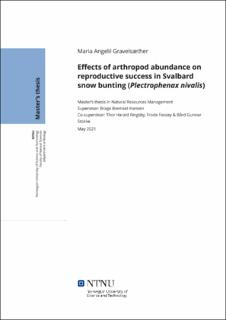| dc.contributor.advisor | Hansen, Brage Bremset | |
| dc.contributor.advisor | Ringsby, Thor Harald | |
| dc.contributor.advisor | Fossøy, Frode | |
| dc.contributor.advisor | Stokke, Bård Gunnar | |
| dc.contributor.author | Gravelsæther, Maria Angelil | |
| dc.date.accessioned | 2021-09-25T16:03:55Z | |
| dc.date.available | 2021-09-25T16:03:55Z | |
| dc.date.issued | 2021 | |
| dc.identifier | no.ntnu:inspera:79539604:51756821 | |
| dc.identifier.uri | https://hdl.handle.net/11250/2782500 | |
| dc.description.abstract | Arktisk oppvarming fører til store miljøforandringer og biologiske forandringer, samt påvirker trofiske interaksjoner. Effekter av klimaforandringer har allerede blitt observert hos flere arktis-hekkende trekkfugler, med deres reproduktive suksess som ofte er avhengig av værforhold og artropoder som matkilde for ungene. Her undersøkte jeg effekten av variasjon i en proxy for artropodeabundans på fitness-relaterte parametere i snøspurven (Plectrophenax nivalis) på Svalbard, samt undersøkte hvordan slike fluktuasjoner igjen kan bli koblet til årlig variasjon i værforhold. Åtte år med data avdekket store mellomårsvariasjoner i mengden og dynamikken av artropodeabundans. Blant de vurderte værvariablene fant jeg kun en tilsynelatende negativ effekt av vind på årlig variasjon i kumulativ artropodeabundans i hekkesesongen. Videre hadde artropodeabundans i den individuelle ungeperioden en positiv effekt på ungevekt, med tendenser til en lik effekt på utflyvingssuksess. Jeg fant også sterke indikasjoner på at tidligere vårstart hadde en positiv tilleggseffekt på ungevekt. Resultatene mine understreker viktigheten av variasjon i mattilgang, samt årlig timing av vårstart, for reproduktiv suksess hos snøspurven. Dette åtte år lange studiet fant ingen bevis på at værforhold knyttet til klimaendringer påvirker årlig artropodeabundans i hekkeperioden. Forventet fremtidig oppvarming i høy-Arktis kan derimot betydelig endre levedyktigheten til populasjoner av trekkfugler, både direkte, og indirekte gjennom trofiske interaksjoner. | |
| dc.description.abstract | Arctic warming causes major environmental and biological changes, also affecting trophic interactions. Effects of climate change have already been observed in several Arctic-breeding migratory birds, with their reproductive success often depending on weather conditions and arthropods as a food source provided to nestlings. Here, I investigated the effects of variation in an arthropod abundance proxy on fitness-related parameters in the Svalbard snow bunting (Plectrophenax nivalis), and how such fluctuations may in turn be linked to annual variation in weather conditions. Eight years of data revealed large interannual variation in the amount and dynamics of arthropod abundance. Among the weather variables considered, I found only an apparent negative effect of wind on annual variation in cumulative arthropod abundance in the breeding season. Furthermore, arthropod abundance in the individual nestling period positively affected chick weight, with a tendency for a similar effect on fledging success. I also found strong indications of earlier onset of spring to have an additive positive effect on chick weight. My findings highlight the importance of variation in prey abundance, as well as annual timing of spring, for snow bunting reproductive success. This eight-year study found no evidence of weather conditions linked with climate warming to affect annual arthropod abundance in the breeding period. However, anticipated future warming in the high-Arctic may significantly alter population viability of migratory birds, both directly, and indirectly through trophic interactions. | |
| dc.language | eng | |
| dc.publisher | NTNU | |
| dc.title | Effects of arthropod abundance on reproductive success in Svalbard snow bunting (Plectrophenax nivalis) | |
| dc.type | Master thesis | |
